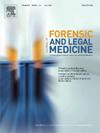A study to determine a practical method for weight estimation of deceased persons
IF 1.2
4区 医学
Q3 MEDICINE, LEGAL
引用次数: 0
Abstract
Background
Body weight is an important parameter for estimating the postmortem interval (PMI) at a crime scene. However, a challenge arises at crime scenes when a weight scale for measuring the total body weight is unavailable. Anthropometry-based models to estimate body weight have been developed in previous studies. This study aims to determine the accuracy of body weight estimations by practitioners, test the anthropometry-based models for applicability to deceased individuals, and examine a potential new method based on applying heel weight.
Methods
A prospective study was conducted at the Isala Hospital in the Netherlands. During the study period, deceased people that were admitted to the hospital mortuary were included consecutively. The body weight of deceased persons estimated by practitioners was compared to the actual body weight. Anthropometric measurements were taken and used to perform eight sex dependant anthropometry-based models, with accuracy for the actual body weight calculated using RMSE values. A Pearson's correlation test was used to determine the correlation between heel weight and total body weight.
Results
During the study period, a total of 100 cases, 56 males and 44 females, were included. Overall, only 33.3 % of practitioners' estimations were within 5 % of the actual measured weight. The model based on abdominal and thigh circumference performed best for weight estimation in males and the models based on mid-arm circumference, abdominal circumference, calf circumference and, in one model, subscapular skinfold performed best in females. A Pearson's correlation test revealed a weak positive correlation between weight of the heel and total body weight (Pearson's correlation coefficient: 0.214).
Discussion
Estimations of underweight or obese patients posed a challenge for weight estimation. Especially in these cases, study results showed that anthropometry-based models have potential for daily practice. However, additional research is required to assess the reliability of the best performing models before implementation in forensic casework. The correlation between the weight of the heel and body weight was low, therefore implementation of the current method is not recommended, and further research is required.
研究确定估算死者体重的实用方法。
背景:体重是估算犯罪现场死后间隔(PMI)的一个重要参数。然而,在犯罪现场,如果没有测量全身重量的体重秤,就会遇到挑战。之前的研究已经开发了基于人体测量学的体重估算模型。本研究旨在确定从业人员估计体重的准确性,测试基于人体测量学的模型是否适用于死者,并研究一种基于脚跟重量的潜在新方法:荷兰伊萨拉医院开展了一项前瞻性研究。方法:在荷兰伊萨拉医院进行了一项前瞻性研究。在研究期间,连续纳入了医院太平间收治的死者。将医生估计的死者体重与实际体重进行比较。研究人员对死者进行了人体测量,并利用测量结果建立了八个基于性别的人体测量模型,利用均方根误差(RMSE)值计算实际体重的准确性。采用皮尔逊相关性检验来确定脚跟重量与总体重之间的相关性:在研究期间,共纳入了 100 例病例,其中男性 56 例,女性 44 例。总体而言,只有 33.3% 的从业人员的估计值与实际测量体重的误差在 5% 以内。基于腹围和大腿围的模型在男性体重估算中表现最佳,而基于中臂围、腹围、小腿围以及肩胛下皮褶的模型在女性体重估算中表现最佳。皮尔逊相关测试显示,脚跟重量与总体重之间存在微弱的正相关(皮尔逊相关系数:0.214):讨论:体重不足或肥胖患者的体重估计是一项挑战。特别是在这些情况下,研究结果表明,基于人体测量学的模型在日常实践中具有潜力。然而,在法医案件工作中实施之前,还需要进行更多的研究,以评估性能最佳模型的可靠性。脚跟重量与体重之间的相关性较低,因此不建议采用目前的方法,还需要进一步研究。
本文章由计算机程序翻译,如有差异,请以英文原文为准。
求助全文
约1分钟内获得全文
求助全文
来源期刊

Journal of forensic and legal medicine
MEDICINE, LEGAL-
CiteScore
2.70
自引率
6.70%
发文量
106
审稿时长
57 days
期刊介绍:
The Journal of Forensic and Legal Medicine publishes topical articles on aspects of forensic and legal medicine. Specifically the Journal supports research that explores the medical principles of care and forensic assessment of individuals, whether adult or child, in contact with the judicial system. It is a fully peer-review hybrid journal with a broad international perspective.
The Journal accepts submissions of original research, review articles, and pertinent case studies, editorials, and commentaries in relevant areas of Forensic and Legal Medicine, Context of Practice, and Education and Training.
The Journal adheres to strict publication ethical guidelines, and actively supports a culture of inclusive and representative publication.
 求助内容:
求助内容: 应助结果提醒方式:
应助结果提醒方式:


